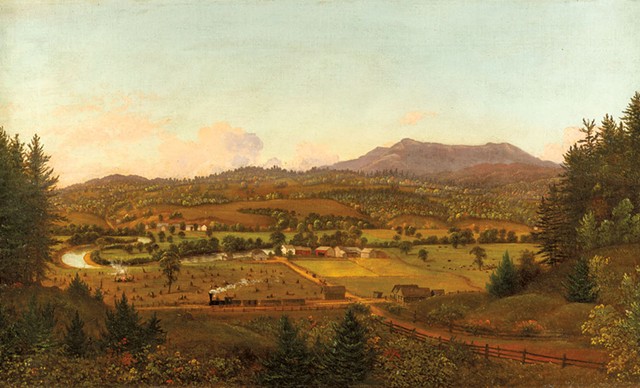
- Courtesy of Shelburne Museum and Andy Duback
- "Steam Train in North Williston, Vermont" by Charles Louis Heyde, ca.1856
Nathaniel Hawthorne's 1843 short story "The Celestial Railroad" satirizes, among other things, a fairly new mode of transportation: The train featured in it never reaches its final station. By 1866, America's tune had changed, and Hawthorne's contemporary, Ralph Waldo Emerson, was enthusing that "Railroad iron is a magician's rod in its power to evoke the sleeping energies of land and water." Train ridership in the U.S. crested in the 1920s at the same time that rail expansion came to a halt, and by the mid-1950s passenger rail had begun a precipitous decline.
The speed of that trajectory is part of what fascinated Shelburne Museum director Tom Denenberg, who cocurated this season's exhibition in the Pizzagalli Center for Art and Education's Murphy Gallery, "All Aboard: The Railroad in American Art, 1840-1955." Principally organized by Denenberg, Kevin Sharp and Julie Pierotti — the last two are director and curator, respectively, of Dixon Gallery & Gardens in Memphis, Tenn. — the show assembles works on loan from around the country to tell a 115-year history of trains in their cultural, economic and social contexts. (It will subsequently travel to Dixon and to the Joslyn Art Museum in Omaha, Neb., the third co-organizing institution.)
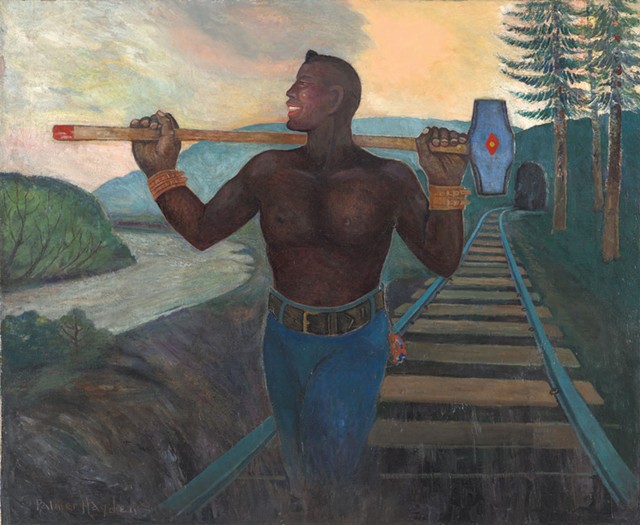
- Courtesy of The Museum of African American Arts
- "His Hammer in His Hand," from the "Ballad of John Henry" series by Palmer C. Hayden, 1944 to 1947
An exhibition title hand-painted by Justin Mayo on vertical wood boards evokes a train car; caboose-red walls beautifully set off more than 40 works, mainly in oil. These span a century of movements in American art, from the Hudson River School to surrealism. Generously informative labels help the artwork coalesce into a study of the country's history through the lens of the railroad, illuminating along the way such topics as the origin of Dixie cups and the song "I've Been Working on the Railroad."
The show opens with examples of how the "iron horse" upended landscape painting, which was dominated in the 1840s by grandiose scenes of nature. In his "River in the Catskills," from 1843, Thomas Cole integrates a barely discernible train into the mid-distance; the majestic mountains beyond it rise unperturbed.
Thirteen years later, Charles Louis Heyde's "Steam Train in North Williston, Vermont" — the only piece in the show from Shelburne Museum's holdings — celebrates the arrival of the Vermont Central Railroad. Heyde's landscape is dominated by human industry rather than nature, evident in the field of tree stumps, network of agricultural fields and the eponymous machine that suddenly expanded the market for farmers' products.
"We all wring our hands about Williston and the big-box stores, but this is the start," Denenberg pointed out during a recent gallery tour.
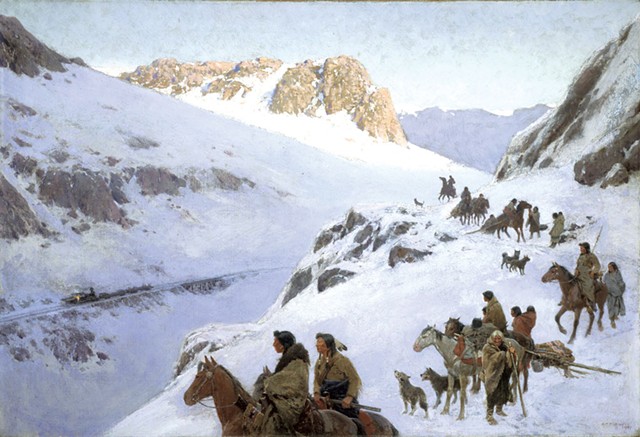
- Courtesy of The National Cowboy & Western Heritage Museum
- "Morning of a New Day" by Henry Farny, 1907
Following the image boost that railroads got from their key role in the Civil War supplying and moving Union troops to victory, the technology soon became a vehicle for westward expansion and manifest destiny. In Henry Farny's 1907 painting "Morning of a New Day," Indigenous people navigating a snowy Rocky Mountain precipice on horseback look down on a train blasting effortlessly through the mountains. The label describes the figures as "spectators of their own impending demise" rather than, more accurately, of their own displacement. But Farny himself was likely as enamored as any white artist of his day by the myth of Indigenous people as a vanishing race doomed by modernity — an idea embodied most famously in Cyrus E. Dallin's 1909 equestrian sculpture "Appeal to the Great Spirit."
Artists didn't just reflect attitudes of the time, as "All Aboard" demonstrates; they sometimes colluded in their propagation. Albert Bierstadt painted "View of Donner Lake, California" from 1871 to 1872, soon after the completion of the transcontinental railroad in 1869. The majestic view includes a train moving through the Donner Pass but no sign of the site's then-recent history of cannibalism. It was commissioned by railroad magnate Collis P. Huntington. And no painting in the show, as a label points out, depicts the Chinese immigrants who built the transcontinental railroad in dangerous and underpaid conditions.
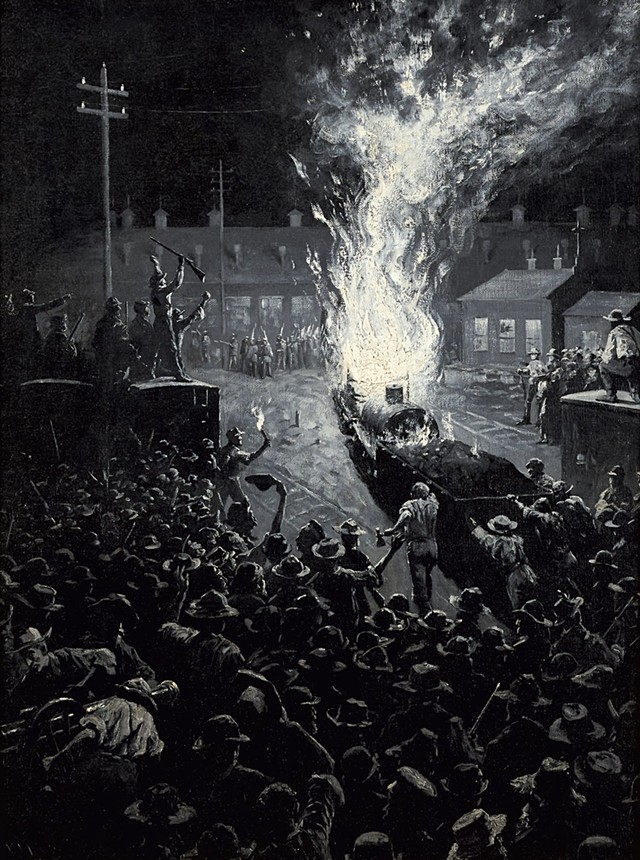
- Courtesy of The Carnegie Museum of Art
- "The Attempt to Fire the Pennsylvania Railroad Roundhouse in Pittsburgh, at Daybreak on Sunday, July 22, 1877" by William Robinson Leigh, 1895
Workers come to the fore in many subsequent paintings, however. William Robinson Leigh's dramatic painting of "The Attempt to Fire the Pennsylvania Railroad Roundhouse in Pittsburgh, at Daybreak on Sunday, July 22, 1877," made nearly two decades later, re-creates a moment in the country's first nationwide strike. Leigh painted it in grisaille for an 1895 magazine article; using black and white made it easier for printers to trace it for photogravure reproduction, Denenberg explained.
By the 20th century, trains had come to represent American mobility, the means by which people left rural life and moved to the cities. Some artists captured the isolation and loneliness associated with that displacement in works that are devoid of people. Georgia O'Keeffe's watercolor "Train Coming In — Canyon, Texas," from 1916, depicts its subject from the front as a tiny shape resembling a dropped pin icon in Google Maps. The train speeds through an area so vast and empty its steam and smoke billows fill the sky (and most of the paper) uninterrupted.
Edward Hopper's exceptionally bleak "Approaching a City," from 1946, is dominated by a blank train tunnel wall that disappears into darkness on the left, as if the city, once reached, will be equally deserted.
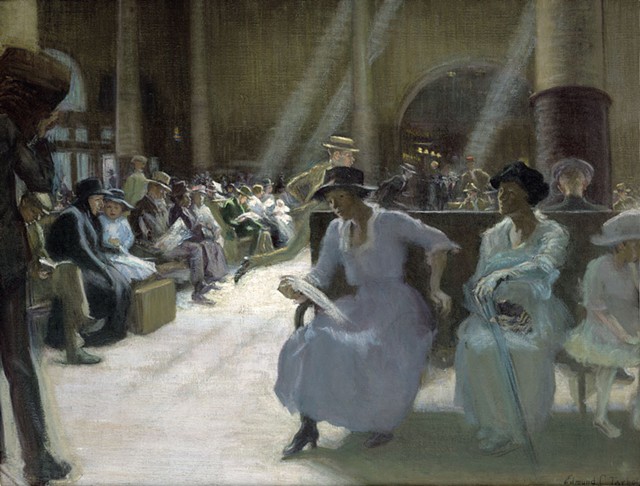
- Courtesy of The Crocker Art Museum
- "In the Station Waiting Room, Boston" by Edmund Charles Tarbell, ca.1915
Other artists chose to depict trains as the great facilitators of social mixing and city life. Warmth pervades John Sloan's 1912 painting of a New York City rush hour, "Six O'Clock, Winter": A few smiles light the faces of the packed pedestrians crowding the painting's bottom edge while the elevated train, backlit by the dusk, looms above them protectively.
"The Carstop," a 1940 painting of a transit intersection in Boston by Allan Rohan Crite, focuses on the distinctive faces and postures of bus, streetcar and elevated railroad passengers crossing paths. The intermingling of Black and white people in the scene captures a moment "before urban renewal changed the social topography of the city in the 1960s and 1970s," the label reads.
Inevitably, artists began associating trains with nostalgia or using them as metaphors. The exhibition's most recently made work, Kay Sage's 1951 "Unusual Thursday," does the latter, if cryptically in the style of Giorgio de Chirico. From a jumble of building elements and bunched fabrics in the foreground, a trestle bridge extends away from the viewer across a flat sea to an unseen point beyond the horizon. Leading, as the label puts it, "to nowhere or infinity — or perhaps both," the absent but implied train is no longer a symbol of unprecedented speed, burgeoning industry, worker power, social fluidity or any of the approaches exemplified in "All Aboard." It is as inscrutable as the course of life itself.











Comments
Comments are closed.
From 2014-2020, Seven Days allowed readers to comment on all stories posted on our website. While we've appreciated the suggestions and insights, right now Seven Days is prioritizing our core mission — producing high-quality, responsible local journalism — over moderating online debates between readers.
To criticize, correct or praise our reporting, please send us a letter to the editor or send us a tip. We’ll check it out and report the results.
Online comments may return when we have better tech tools for managing them. Thanks for reading.